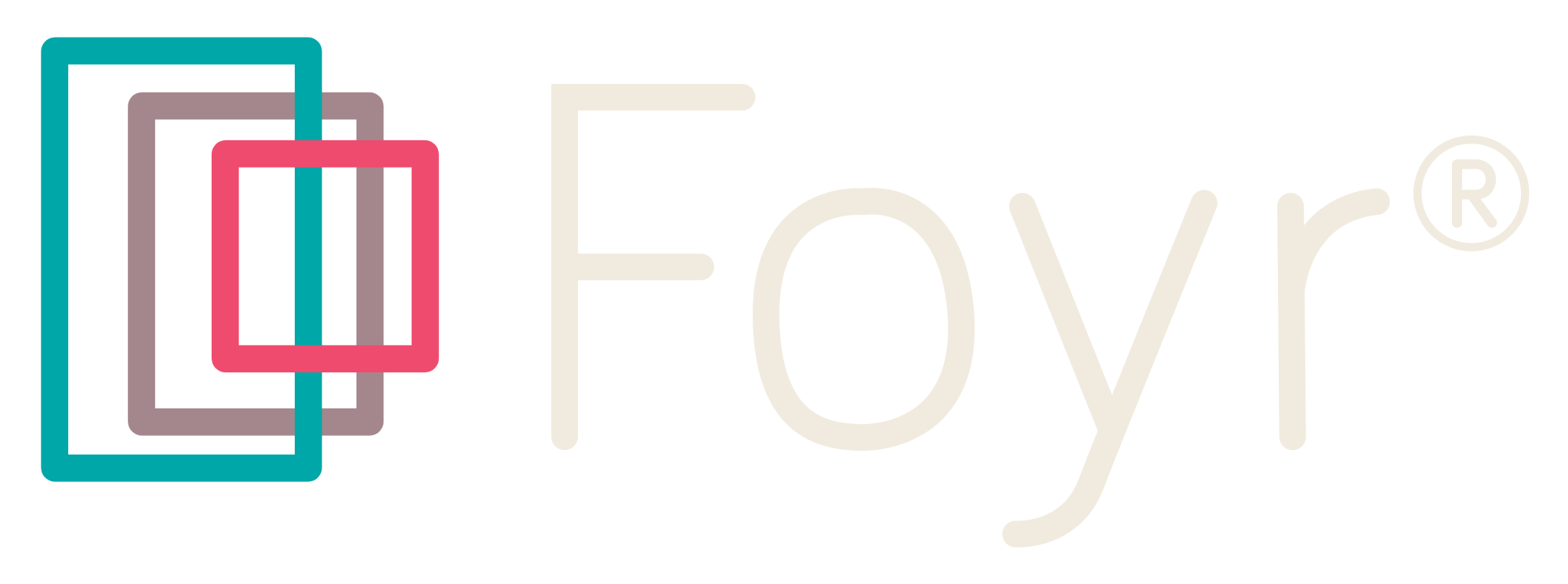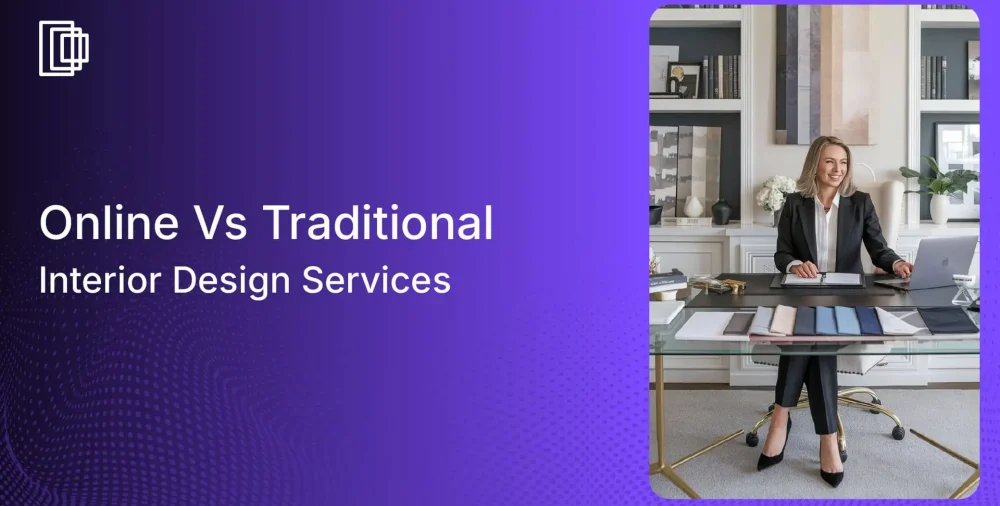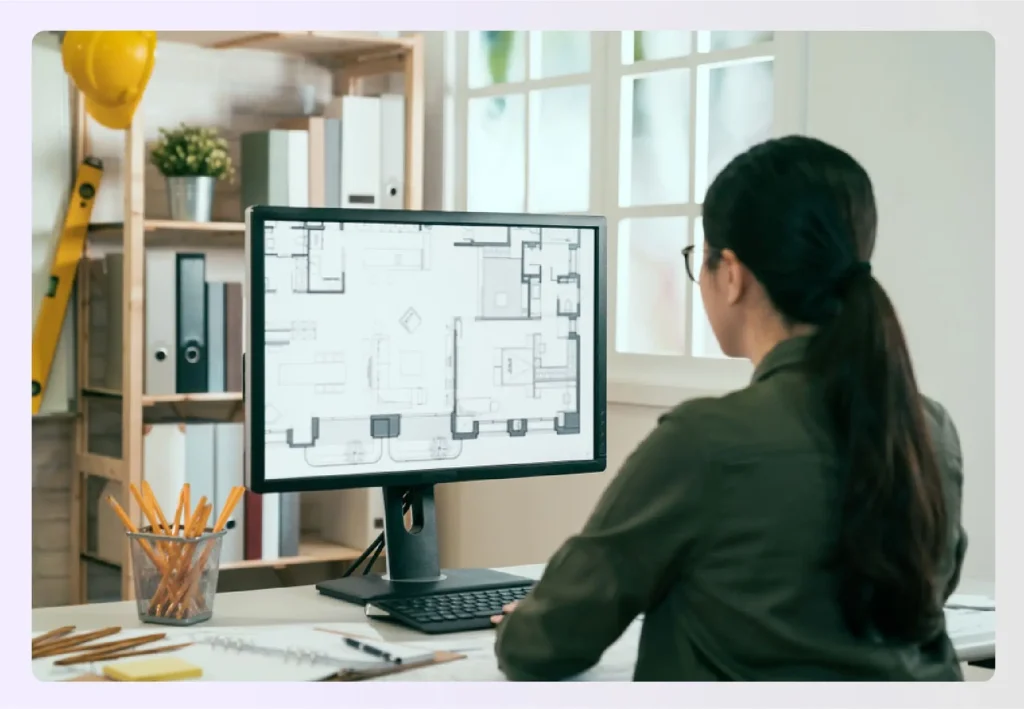Table of Contents
The interior design industry is booming. Valued at USD 145.37 billion in 2025 and projected to reach USD 186.61 billion by 2030, the market is experiencing unprecedented growth, and a fundamental shift in how services are delivered.
What was once exclusively an in-person, high-touch service is now accessible through digital platforms and virtual collaboration tools. Homeowners today have two distinct paths when it comes to interior design: work with a designer remotely through online services, or choose traditional in-person consultation and full-service management.
In this comprehensive guide, we’ll break down everything you need to know from costs and timelines to processes and deliverables, so you can choose the approach that fits your budget, timeline, and vision.
What is Online Interior Design (E-Design)?
Online interior design, also called e-design, allows you to work with professional designers remotely using digital tools and cloud-based platforms. Instead of scheduling in-person consultations, you submit room measurements, share photos of your space, and communicate your style preferences, all through email, video calls, or project management platforms.
The designer creates a comprehensive design plan, complete with floor layouts, mood boards, product recommendations, and shopping links. You receive everything digitally and implement the design at your own pace. It’s interior design expertise without the geographic limitations or higher costs of traditional services.
Key Features of Traditional Interior Design
Traditional interior design begins with in-person consultations. Your designer visits multiple times for assessment, material selection, progress checks, and final styling. They experience your space under actual lighting conditions, catching details photos miss.
Physical material sampling eliminates guesswork. Touch fabrics, see paint colors on your walls, and examine finishes in your home’s natural light. Your designer brings samples directly to you for confident decision-making.
Comprehensive project management makes the process turnkey. Your designer handles contractor hiring, delivery coordination, and installation oversight. You get a finished space with minimal involvement.
Trade and vendor access opens doors that the general public can’t reach. Through your designer’s industry relationships, access wholesale pricing, trade-only showrooms, and custom fabricators for unique pieces and materials.
Custom solutions and quality oversight set traditional design apart. Create bespoke cabinetry, built-in furniture, or one-of-a-kind pieces designed for your space. Your designer attends key installations to ensure flawless execution.
Best Projects for Traditional Interior Design
Traditional interior design is essential for:
- Major renovations – Kitchen and bathroom remodels requiring construction and contractor coordination
- Whole-home projects – Multiple rooms that need cohesive design and phased implementation
- Structural modifications – Projects involving walls, plumbing, electrical work, or architectural changes
- Custom home builds – New construction requiring design decisions from foundation to finishes
- Luxury interiors – High-end projects with custom furniture, rare materials, and bespoke details
- Historic home updates – Renovations requiring permits, preservation considerations, and specialized expertise
Now that you understand what each approach offers, let’s dive deeper into the specific advantages and trade-offs. Every design method has strengths and limitations, here’s an honest look at what you gain and what you give up with each choice.
Pros and Cons of Online Interior Design
Online interior design has revolutionized accessibility to professional design services, but it’s not without limitations. Understanding both the advantages and challenges helps you set realistic expectations and determine if this approach fits your project needs.
Advantages of Online Interior Design
- Dramatic Cost Savings
Pay $500-$1,500 per room instead of $5,000-$30,000+ for traditional services. Lower overhead means you’re investing in design expertise, not travel time or office expenses. - Access to Global Design Talent
Geography doesn’t limit your options. Work with specialized designers nationwide whose aesthetic perfectly matches your vision. - Fast Project Timelines
Receive initial concepts within 1-2 weeks and complete design packages within 3-4 weeks total, significantly faster than traditional services. - Flexible Implementation Schedule
Implement changes at your own pace. Purchase items as budget allows and tackle projects room by room without pressure or rushed timelines. - Perfect for DIY Enthusiasts
Maintain control while getting professional guidance. Ideal if you enjoy hands-on projects and want creative direction without relinquishing decision-making power. - Convenient Communication
Review designs on your lunch break, provide feedback from anywhere, and communicate on your schedule.
Challenges of Online Interior Design
- Limited Hands-On Material Experience
Make decisions from digital images and swatches without seeing full-size samples in your space. Colors and textures can appear different on screens than in actual lighting. - Potential Communication Gaps
Nuances can be lost without face-to-face interaction. Clear photos and detailed written communication become essential for conveying your vision accurately. - DIY Implementation Responsibility
You handle all purchasing, delivery coordination, furniture assembly, and spatial arrangement. The cost savings comes with time and effort investment. - Self-Guided Problem Solving
Troubleshoot fit issues and implementation challenges independently, or pay additional fees for designer consultation beyond the initial package. - Technology Requirements
Requires comfort with digital tools – taking photos, uploading files, video conferencing, and navigating online platforms or project dashboards. - Not Suitable for Complex Projects
Construction oversight, contractor coordination, and custom fabrication need hands-on involvement that online services cannot provide.
Pros and Cons of Traditional Interior Design
Traditional interior design offers comprehensive, hands-on service throughout your project, but comes with higher costs and longer timelines. Here’s what to expect from the full-service approach.
Advantages of Traditional Interior Design
- Physical Material Sampling
Touch fabrics, see paint on your walls, and examine finishes in your home’s actual lighting. This tactile experience eliminates guesswork and builds selection confidence. - On-Site Expertise and Problem Solving
Your designer assesses unexpected issues in person and pivots quickly with solutions, crucial during renovations when problems frequently arise. - Full Project Management
From contractor hiring to delivery coordination and installation oversight, your designer handles all logistics for a truly turnkey experience. - Access to Trade-Only Resources
Tap into wholesale vendors, custom fabricators, and trade-only showrooms through your designer’s industry relationships. - Personalized, Hands-On Approach
Build rapport through face-to-face meetings. Your designer develops a deep understanding of your lifestyle, preferences, and needs through direct conversation. - Quality Control and Installation Oversight
Your designer is present during key installations to ensure correct execution that matches the design vision exactly.
Challenges of Traditional Interior Design
- Significantly Higher Investment
Services cost $5,000-$30,000+ depending on scope. You’re paying for comprehensive management, in-person time, and trade access, not just design concepts. - Extended Project Timelines
Expect 2-3 months minimum for single rooms, often 6-12 months for major renovations. In-person meetings, contractor coordination, and custom sourcing extend timelines considerably. - Geographic Limitations
You’re restricted to designers in your area or those willing to travel at additional cost. This limits options, particularly in smaller markets. - Scheduling Complexity
Coordinating calendars for designer, contractors, vendors, and yourself creates logistical challenges that can slow project progress. - Less Control Over Process
While the hands-off approach appeals to many, some clients feel disconnected from daily decisions and don’t see details until completion. - Higher Commitment Level
Requires greater upfront commitment in time, budget, and decision-making. Pausing or scaling back mid-project is difficult once construction begins.
Understanding the pros and cons is helpful, but what does each approach actually look like day-to-day? Let’s walk through the step-by-step process for both methods so you know exactly what to expect from start to finish.
What to Expect: The Online Vs Traditional Interior Design Process
Understanding the step-by-step process for each approach helps set realistic expectations and prepares you for what’s ahead. Here’s how each design journey typically unfolds.
The Online Interior Design Process
Week 1: Discovery
Complete a style questionnaire, submit room measurements and photos, and have an initial video call to discuss your vision.
Week 2: Design Concepts
Receive floor plans, mood boards, color schemes, and preliminary product selections digitally.
Week 3: Revisions
Review concepts and provide feedback. The designer refines the plan based on your input (typically 1-2 revision rounds included).
Week 4: Final Package
Get your complete design package with detailed floor plans, shopping links, paint colors, and implementation instructions.
Ongoing: Implementation
Purchase items and arrange your space at your own pace. Optional add-on support available for questions.
Total Timeline: 3-4 weeks
Your Time: 5-8 hours total
The Traditional Interior Design Process
Weeks 1-2: Initial Consultation
The designer visits your home, takes measurements, assesses conditions, and you sign a contract outlining scope and fees.
Weeks 3-4: Concept Development
The designer creates space plans, material selections, and initial renderings for presentation.
Weeks 5-6: Material Selection
Multiple in-person meetings to review physical samples – fabrics, finishes, paint colors – and make final selections together.
Weeks 7-8: Planning & Coordination
Designer creates specifications, sources custom items, obtains contractor quotes, and coordinates project timeline.
Week 9+: Implementation
Construction begins with regular designer site visits to oversee work, coordinate deliveries, and ensure quality.
Final Phase: Styling
The designer handles final touches – accessories, artwork, furniture arrangement – and conducts final walkthrough.
Total Timeline: 8-12 weeks for single rooms; 6-12 months for renovations
Your Time: 20-30 hours across multiple meetings and site visits
Now that you’ve seen how each process unfolds, let’s put everything side-by-side for a clear, at-a-glance comparison. This table summarizes all the key differences to help you evaluate which approach aligns with your project needs.
Online vs Traditional Interior Design: Complete Comparison
| Feature | Online Design (E-Design) | Traditional Design |
| Average Cost | $500–$1,500 per room | $5,000–$30,000+ per project |
| Project Timeline | 3-4 weeks for design package | 2-12 months depending on scope |
| Designer Access | Global – work with anyone | Local or regional only |
| Communication | Email, video calls, project platforms | In-person meetings and site visits |
| Personalization | Moderate – guided by photos and descriptions | High – based on in-person collaboration |
| Material Selection | Digital references, client orders samples | Physical samples brought to your home |
| Site Assessment | Done by client with photos and measurements | Done by designer with in-person visits |
| Implementation | Client handles all purchasing and arranging | Designer manages everything |
| Project Management | Self-managed by client | Comprehensive oversight by designer |
| Revisions Included | 1-2 rounds typically | Ongoing throughout project |
| Best For | Cosmetic updates, furniture layout, styling | Renovations, construction, custom work |
| Requires | DIY comfort, basic tech skills | Larger budget, time for meetings |
| Access to Trade Vendors | No (retail purchases only) | Yes (wholesale and custom sources) |
| Construction Oversight | Not included | Included in full-service packages |
The comparison gives you the facts, but how do you actually make the decision? It comes down to six key factors. Work through these questions honestly, and the right choice will become clear.
How to Choose Between Online vs Traditional Interior Design
Step 1: Assess Your Project Complexity
Choose Online Interior Design if:
- Your project is cosmetic only – furniture, paint, decor, window treatments
- No construction, plumbing, or electrical work required
Choose Traditional Interior Design if:
- Your project involves construction, renovations, or structural changes
- You need contractor coordination, permits, or custom built-ins
The key question: Does your project require construction oversight? If yes, go traditional. If not, online can handle it.
Step 2: Determine Your Realistic Budget
Choose Online Interior Design if:
- Your design budget is under $2,000 per room
- You’re willing to handle implementation yourself to save money
Choose Traditional Interior Design if:
- Your budget exceeds $5,000 per room for design services
- Your total project budget is over $50,000
Budget reality check: Traditional design fees are typically calculated as a percentage of your total project budget or hourly rates, making comprehensive projects a significant investment.
Step 3: Consider Your Timeline Requirements
Choose Online Interior Design if:
- You need design concepts within 3-4 weeks
- You want flexibility to implement at your own pace
Choose Traditional Interior Design if:
- You have a firm move-in or completion deadline
- You want everything completed and managed for you
Timeline truth: Online delivers concepts faster, but you control implementation pace. Traditional takes longer but delivers a finished space.
Step 4: Evaluate Your DIY Comfort Level
Choose Online Interior Design if:
- You enjoy hands-on projects and have time for implementation
- You’re comfortable coordinating purchases, deliveries, and assembly
Choose Traditional Interior Design if:
- You want turnkey service with zero personal involvement
- The thought of DIY implementation causes stress
Be honest: Your comfort level significantly impacts satisfaction.
Step 5: Check Location and Access Factors
Choose Online Interior Design if:
- You live in a remote area with limited local designers
- You want to work with a specific designer regardless of location
Choose Traditional Interior Design if:
- You have access to quality local designers you love
- Your project requires frequent in-person site visits
Location consideration: Online design removes geography as a barrier entirely.
Choosing between online and traditional design used to mean compromising on either convenience or quality. But modern technology is changing that equation.
How Foyr Neo Bridges Both Worlds
Whether you’re an experienced interior designer managing multiple client projects or a homeowner exploring design possibilities for your own space, Foyr provides comprehensive interior design software that adapts to your needs. This powerful cloud-based platform seamlessly bridges the gap between online efficiency and traditional design quality.
Foyr combines intuitive ease of use with robust professional capabilities that work equally well for quick cosmetic updates and complex renovation projects. What truly sets it apart is how it addresses the core challenges of both design approaches:
- Lightning-Fast 12K Renders: Generate photorealistic visualizations in minutes, dramatically reducing client wait times
- 60,000+ Product Library: Access extensive render-ready 3D models, eliminating time-consuming sourcing work
- Cloud-Based Accessibility: Design from any device, anywhere, enabling true location-independent workflow
For Traditional Design Quality:
- Photorealistic Visualization: Help clients make confident decisions with the same certainty physical samples provide
- Real-Time Collaboration: Share designs, gather feedback, and make live adjustments during client presentations
- Precision Planning Tools: Drag-and-drop smart layouts with rulers and guidelines ensure accurate spatial planning
AI-Powered Features That Accelerate Your Workflow:
- AI Magik Bar: Transform designs instantly by typing simple commands to add, change, or delete elements
- Trace Your Floor Plan: Convert uploaded floor plans into workable 3D designs automatically
- Individual Product Lighting: Fine-tune ambiance by controlling each light fixture independently
Foyr empowers you to deliver professional results that distinguish your work in the competitive design landscape.
Start designing with Foyr Neo’s 14-day free trial and experience professional interior design tools that work for any project type – online, traditional, or hybrid.
Frequently Asked Questions on Online Vs Traditional Interior Design
1. Is online interior design worth it?
Yes, for cosmetic design projects like furniture arrangement, color selection, and room styling. Online design delivers professional results at 60-80% lower cost than traditional services.
2. How much does online design typically cost?
Online interior design costs $500-$1,500 per room on average. Basic packages start around $300-$500 for floor plans and shopping lists. Standard packages ($500-$1,000) include mood boards and 3D renderings. Premium packages ($1,000-$1,500+) offer multiple concepts and extensive revisions. Most include 1-2 revision rounds.
3. Can I mix modern and traditional decor?
Absolutely! This creates “transitional style” one of today’s most popular design approaches. Maintain balance through consistent color palettes, proportional mixing (one modern piece with one traditional), complementary textures, and unified metal finishes. Both online and traditional designers can help you achieve this look successfully.
4. What is the best website platform for interior design?
For professional designers, Foyr Neo leads with drag-and-drop floor planning, real-time collaboration, photorealistic 4K rendering, and 60,000+ product models.
5. Is traditional decorating out of style?
No, it’s evolved. While heavy Victorian styles are less common, updated traditional design remains timeless and popular. Modern traditional (“transitional”) blends classic elements with contemporary simplicity – clean-lined classic furniture, fresh colors on architectural details, and antiques mixed with modern pieces. Traditional interior design services (in-person design) are still essential for complex renovation projects.












